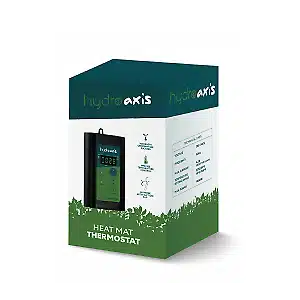The Warm Embrace: Using Heat Mats with Thermostats for Thriving Seedlings and Microgreens

The Warm Embrace: Using Heat Mats with Thermostats for Thriving Seedlings and Microgreens
For Aussie gardeners eager to kickstart their veggie patches or cultivate a bounty of microgreens indoors, heat mats can be a game-changer. These handy tools gently warm the soil, mimicking ideal germination temperatures and accelerating the growth process. But how exactly do you harness the power of heat mats for successful seed starting and microgreen production? Let's delve into the warm and toasty world of heat mats, exploring their benefits, considerations, and the key differences between using them for seedlings and microgreens, all while emphasizing the critical role of thermostats in our unique Australian climate.
The Heat is On: Understanding Heat Mats and the Importance of Thermostats
Heat mats are electric mats that radiate warmth directly into the soil. They typically operate at a constant temperature, around 10-20°C above the ambient room temperature. This gentle boost in soil temperature is crucial for many seeds, particularly those that prefer warmer conditions for germination. However, the effectiveness of heat mats hinges on maintaining a consistent and optimal temperature throughout the entire 24-hour cycle. This is where a thermostat becomes an essential partner in your indoor growing journey.
The Daily Temperature Tango:
Australia's climate, particularly in certain regions, presents a unique challenge for seed germination. While daytime temperatures might soar high enough for some seeds to germinate (think warm Melbourne springs!), nighttime often ushers in a significant drop (those chilly Sydney nights!). This daily temperature fluctuation can wreak havoc on your delicate seedlings.
- Nighttime Chill: Without a heat mat and thermostat, nighttime temperatures might plummet below the ideal range for germination, hindering or even halting the sprouting process. Seeds that do germinate may be weak and struggle to thrive.
- Overheating Risk: Heat mats on their own, especially without a thermostat, can struggle to adapt to the daily temperature shifts. During the day, they may continue to radiate heat, potentially overheating the soil if the ambient temperature is already high. This can damage or even kill seedlings.
Thermostats: The Maestro of the Mat:
A thermostat acts as the conductor of your heat mat, ensuring the perfect soil temperature for your seeds 24/7. Here's how it keeps the germination party going:
- Consistent Warmth: The thermostat allows you to set a precise temperature ideal for your chosen seeds. It then regulates the heat mat's output, ensuring the soil stays consistently warm throughout the day and night.
- Night Shift Hero: During those chilly nights, the thermostat kicks in, activating the heat mat and maintaining the optimal temperature for germination. This prevents seeds from experiencing a growth stall or succumbing to the cold.
- Daylight Safety Net: If the daytime temperature rises significantly, the thermostat automatically reduces the heat mat's output, preventing the soil from overheating. This is particularly crucial in Australian summers when daytime temperatures can climb quickly.
Seeds Rejoice: Benefits of Heat Mats with Thermostats
- Faster Germination: Warm soil with consistent temperature regulation from a thermostat encourages seeds to sprout quicker, giving you a head start on your gardening journey.
- Improved Seedling Success: Consistent warmth optimises root development, leading to stronger and healthier seedlings.
- Extended Growing Season: Heat mats with thermostats allow you to start seeds earlier in the season, even when outdoor temperatures are still a little chilly, and keep them thriving throughout the year despite the daily temperature fluctuations.
Microgreens vs Seedlings: Tailoring Your Approach
While both seedlings and microgreens benefit from warmth, there are slight differences in how to use heat mats with thermostats for each:
- Microgreens: These fast-growing superstars often thrive in temperatures ranging from 18-24°C. Heat mats with thermostats are particularly beneficial for microgreens harvested earlier in their growth cycle, as these stages often require warmer soil temperatures.
- Seedlings: Many vegetable seeds germinate best between 21-27°C. Heat mats with thermostats can be especially helpful for heat-loving vegetables like tomatoes, peppers, and eggplants. Once seedlings emerge, they may not require the heat mat anymore, depending on the ambient temperature and the thermostat settings.
Humidity Matters: Striking a Balance
Heat mats can increase evaporation, potentially leading to dry soil. Here's how to maintain the right balance of warmth and moisture:
- Use a Humidity Dome: A humidity dome traps moisture released from the soil, creating a mini-greenhouse effect. This is particularly helpful during germination for both seedlings and microgreens.
- Monitor Moisture Levels: Check the soil daily. If it feels dry to the touch, lightly mist the surface or add a small amount of water





